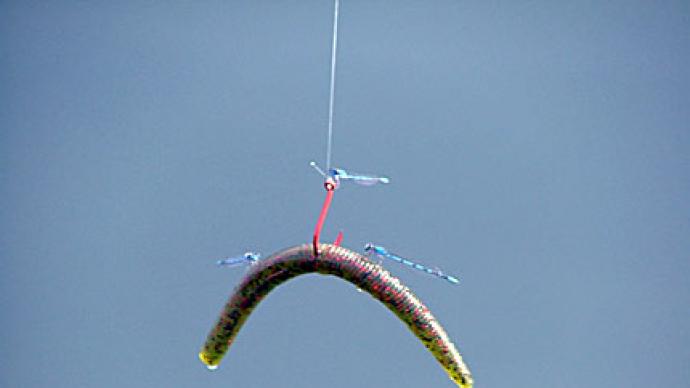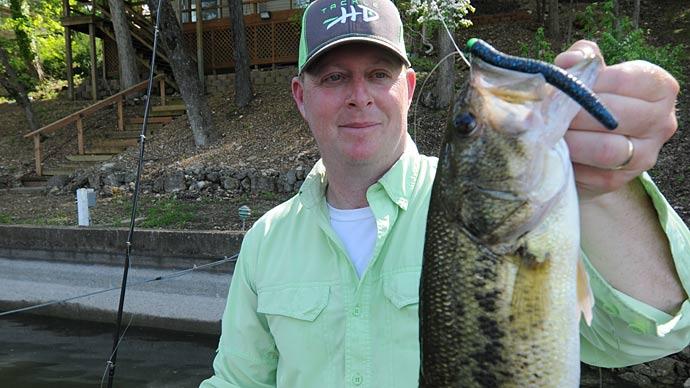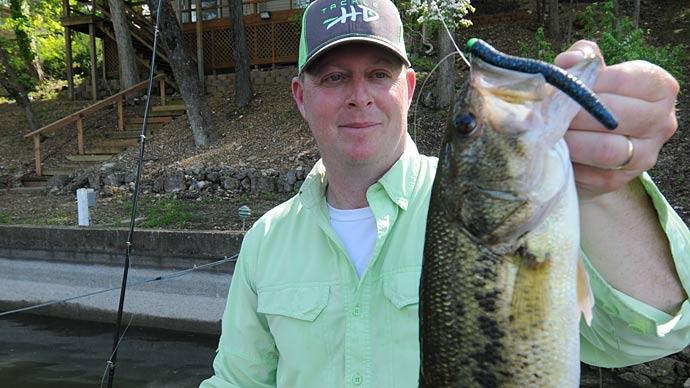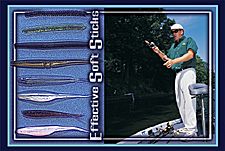
Slug-Gos, Flukes, Senkos, Centipedes, and more - these simple soft-plastic sticks have generated quite a buzz in the bassing world over the years.
Sticks are soft-plastic creations with no built-in action. They are about as Plain Jane as a lure can be. However, in the hands of a skilled angler, soft sticks become incredibly alluring. With a mere quiver, a stick can draw a strike response from nearby bass. Furthermore, anglers themselves are captivated by observing bass boil and engulf these lures. From any point of view - bass or bass angler - soft sticks are effective.
Soft sticks fall into two general categories. Generically referred to as soft jerkbaits, the first group is represented by Slug-Go, Super Fluke, Bass Assassin Straight Tail Shads, and others. These feature a thicker head and belly with a tapered tail - sometimes forked like a baitfish. Rigged on an offset extra-wide-gap hook, soft jerkbaits are fished with retrieves ranging from a deadstick drift to rapid cadence jerking.
The second category of soft sticks is often referred to as fry worms because they resemble French fries. Symmetrical in appearance, these sticks do not have a defined head or tail; instead, they look like short blunt-end worms. Familiar names include Centipede and Senko. Generally rigged in one of two methods - Texposed or center-hooked wacky style - these sticks are often presented as drop or drag baits.
While both styles of sticks have been around since the late 1980s, acceptance by competitive anglers in some regions of the country was slow. Viewed by some of the tournament community as gimmicky, soft sticks had to prove themselves in the heat of battle to secure a spot in the tackle box.
Sticks On Tour
"Soft sticks, I love them all! I'm an avid user of Flukes, Senkos, and Centipedes," said Marcel Veenstra, a pro on the FLW Tour. Veenstra explains that soft sticks played a pivotal role for him in nearly every Northern event last year. "Soft sticks secured my spot in the Tour," he said.
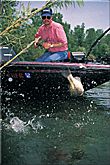
At the division opener on the Mississippi River, Veenstra observed large numbers of recently vacated beds in the protected shallows. Reasoning that exhausted bass would not move into the main-river current, he found bass cruising marina jetties just outside the stronger currents but unwilling to attack any conventional lure.
"I rigged a 4-inch green pumpkin Senko without any weight and pitched it to the break walls," Veenstra said. "I let the Senko drift to the bottom, giving it a twitch now and then. It was a slow, methodical approach, but it was the best way to catch these postspawn recovering fish."
At Lake Champlain in July, Veenstra achieved a third-place finish by changing his presentation each day as bass became more finicky due to fishing pressure. By the final day, he narrowed his focus to two differently rigged sticks to collect his bag of fish. One was an exposed-hook wacky-rigged Senko fished around sparse grass clumps; the other was a Texposed Senko for the thicker grass beds.
"At the last event for the season, I wacky-rigged a 5-inch Senko, casting it to areas that had a combination of rock and grass immediately adjacent to deep water," Veenstra said. "But current and wind made it difficult to get a weight-free wacky rig down. So I put a small Mojo weight 15 inches in front of the wacky-rigged Senko - now that was a little different approach that worked!"
Soft sticks were also part of Veenstra's game plan during the Championship at Lake Martin. In the early morning, he cast a 5-inch Senko to banks where spotted bass were cruising. Later, with the sun higher in the sky, he pitched the same bait under docks.
Southern Stickin'
Pro Ray Scheide of Cookson, Okla., has been a soft-stick aficionado since an incident on Sam Rayburn a few years ago. During practice, he was catching good prespawn fish on jigs in trees. But come the first day of the tournament. The fish had abruptly moved.
"I followed the creek channel back to a bedding area where I caught up with the fish," he said. "Now I could see the fish, but they would not touch a thing until I started casting a soft jerkbait, and the bass ate it like candy. Every cast resulted in an explosion, and the livewell was filled quickly. That gave me more confidence in soft sticks than ever. Now they are among my favorite baits."
Nowadays, Scheide has one or more soft sticks tied on different rods when practicing for a tournament. "It is probably the best search bait I have ever used," he said. "Sometimes it is exactly what they want, and other times it will result in bass simply making their presence known by swiping at it. Come tournament day, I'll have a Terminator Soft Jerkbait on one of my rods, even if I didn't get the fish to eat one in practice. It's the bait you should always have ready when the opportunity presents itself."
Scheide says his second-place finish at the Kentucky Lake event last season was attributed to a soft stick. "Bass would not chase a bait after the first day," he said. "I was still getting some bites by pitching a lightweight Terminator Finesse Jig, but even that presentation faded as the bass became increasingly finicky. If you had even the lightest weight, the bait fell too quickly to attract any interest from the fish. To catch bass on the third day, I threw a weightless Senko into areas where I thought bass should be and slowly dragged it back to the boat. This caught bass behind other competitors who had fished the area without a bite."
Stickin' Good Reason
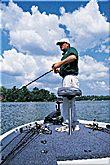
"Although I haven't won a tournament strictly with a soft stick-type bait, these baits have repeatedly contributed key fish at critical junctures in a competition," said Champion Joe Balog of Independence, Ohio. "Those high-place finishes are as important as a win when fishing a circuit. To put it plainly, soft sticks have saved my butt on more than one occasion."
As a seminar instructor on the Hawg Trough during the winter sports show season, Balog frequently explains to audiences why he believes something as simple as a soft stick is so effective. He acknowledges that a bass may attack a lure because it is being worked like an injured baitfish. But he believes that bass are looking for disoriented baitfish separated from the school rather than injured ones. In the grand scheme of things, however, whether the lure is mistaken for an injured or lost baitfish is irrelevant. The key is the erratic movement.
"Bass subjected to intense angling pressure come to recognize the rhythm of certain lures," Balog said. "It's possible they associate it with danger or at least with something unnatural. The more mechanical or repetitive the action, the less likely a bass will attack the bait. Every crankbait or spinnerbait is retrieved in the same manner regardless of whether I throw it or you throw it.
"However, when you cast a weightless soft stick with no built-in action, the angler must impart the action to the bait - as little or as much as the fisherman feels is needed. No two anglers will identically fish a soft stick. Heck, no angler can repeat the same action on the next cast. When it comes down to a fish deciding whether to grab the lure, the unpredictable behavior of a soft stick will win out over the mechanical action of a hard lure or even a soft plastic with the weight directly attached to it."
Stick Season
From Scheide's perspective, the soft-stick season starts in the spring when the water temperature reaches 55 degrees and concludes in the fall when bass are back in the shallows chasing shad. "For me, the peak periods for a soft jerkbait are prespawn and postspawn," Scheide said. "On the other hand, a Senko has a special knack for tricking those bass sitting on beds."
Scheide rigs his Big Bite Baits Jerk Minnow on a 3/0 offset hook with 20-pound-test fluorocarbon line, tying a barrel swivel in-line about 18 inches above the hook. "I work the bait with a jerk, jerk, pause, similar to a Rouge retrieve," he said. "You want to work the soft jerkbait back and forth slowly enough that it's barely visible underwater. Seeing the strike makes for exciting fishing!"
On the other hand, Scheide fishes a Texas-rigged Senko (on the same 3/0 hook) simply by casting and letting it sink to the bottom - perhaps in water as deep as 8 feet. If he does not get a bite during the do-nothing part of the presentation, Scheide will begin a painstakingly slow retrieve that attempts to maintain bottom contact to the boat.
"Strikes can be incredibly subtle," he said. "You must be adept at line-watching. Set the hook if you even sense a tick in your line without really seeing it."
While the spawn is considered by many as the prime time for deadsticking a fry-type stick, Scheide feels a Senko has potential anytime. "I've never seen a bait that will consistently catch bass all season long as well as a Senko," Scheide said. "This is the perfect bait for a co-angler to fish behind a pro. Generally, a pro will be fishing for the aggressive fast bite, but a co-angler can score with a soft stick no matter what time of the year."
Balog points to fall as his favorite soft-sticking time with a Super Fluke or Berkley Jerk Shad. However, he insists on a 5/0 hook and 15-pound test Big Game line.
"At this time of the year, bass are on the flats chasing shad," Balog said. "Those fish don't care about anything but baitfish and may be found in some very shallow, fairly clear water. They are easily spooked, but a soft jerkbait is the ideal presentation - it touches down on the water with minimal splash and has no flash. I work the bait quickly to simulate a shad separated from the school, concentrating my casts around slight depressions, ditches, and the back end of creek channels. This is simply an awesome pattern on Southern reservoirs."
Veenstra applies soft-stick techniques throughout the season in a variety of situations. For soft jerkbaits, he chooses a 4/0 hook, going with 10-pound Trilene XL for open water or 15-pound XT for fishing weeds and wood. He drops the hook size to 1/0 or 2/0 for Centipedes and Senkos.
Veenstra utilizes soft jerkbaits for both largemouth and smallmouth. "For smallies, I work the Fluke fairly quickly with a rapid jerk-jerk-pause," he said. "But for largemouth, I change the tempo to a slower retrieve, so the bait glides side to side."
In most instances, Veenstra relies on a Senko-style stick as vertical drop bait. The center hooked wacky rig is his favored presentation, although he switches to Texposed rigging in dense weeds. In addition, Veenstra rigs a Zoom Centipede with a Mojo weight to create a miniature Carolina rig for quickly covering shallow flats in the spring or when dealing with river currents during the summer and fall. Separated from the weight by 15 inches of line, the soft stick still maintains random movements that trigger bites.
The pros understand that soft sticks produce when other baits fail. So don't leave home without them.
More Options
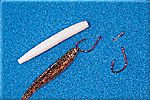
Pro Dave Lefebre of Erie, Pa., suggests making a soft jerkbait even more weed-resistant by rigging a Super Fluke upside down. Instead of having the hook coming out the back, flip the bait, so its belly slit becomes the top of the bait. Now the hook point can be protected entirely by the slit.
Lefebre also modifies a soft jerkbait to make it more effective for schooling bass. First, he takes a feathered treble and ties it on the line with a Palomar knot, leaving 12 to 15 inches of line as if rigging a drop-shot. Next, he ties a 5/0 Gamakatsu EWG on the tag end. Next, he cuts a half-inch off the head of an original Slug-Go (or other solid-head jerkbait) to create a blunt end. Finally, the Slug-Go is rigged Texposed on the 5/0 hook.
"Modeled after the Front Runner idea, I fish this rig for surface-busting smallmouth," Lefebre said. "The blunt nose gives you a spitting soft jerkbait. Also, the hook-ups with smallmouth on the soft jerkbait are more secure than with a Pop-R or other hard bait."
Making It Last
It's no secret that a Senko only lasts for a short time on the hook. In many instances, one strike from a fish will tear it from the hook. This is particularly true when rigged wacky-style with the hook through the middle of the Senko.
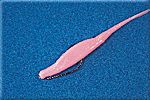
The trick is to make the bait last through a few fish. When wacky-rigging, try snipping a 3/4-inch hollow section from a tube lure and sliding it over the Senko to reinforce the middle where the hook is placed. Another equally effective trick is placing a small rubber band over the Senko's middle and slipping the hook under the rubber band. Dental rubber bands obtained at a dental supply office work best.
Even when rigged Texposed, a Senko may not last long. To get an extra fish or two per bait, try a hook with a keeper insert rather than using a hook with an offset bend.
What Color Stick?
As with any soft-plastic bait, sticks are available in various colors. Each angler will develop confidence with particular colors based on their experience. Pro Marcel Veenstra offers some recommendations for initial color selections:
"For soft jerkbaits, I suggest three basic colors - white pearl, albino shad, and watermelon seed," he said. "For Senkos and Centipedes, my top color picks are green pumpkin and watermelon with black flake. I will use a more transparent color with silver flakes in super-clear water. When fishing for smallmouth or spotted bass, I occasionally dip the end of a soft stick in chartreuse dye - at times, that can make a difference in the number of bites."
Content provided by Bass Fishing Magazine, the official publication of FLW Outdoors


